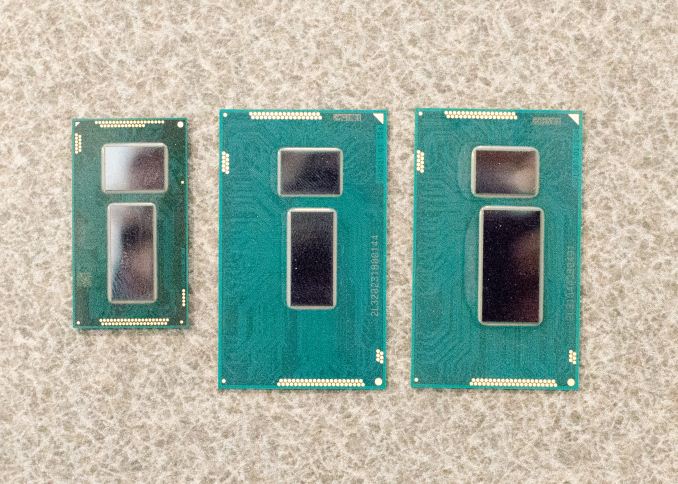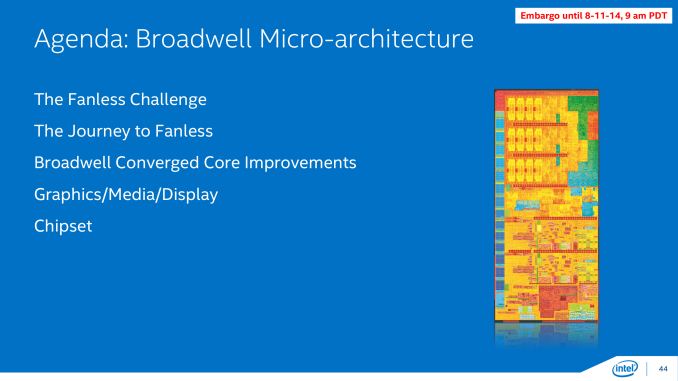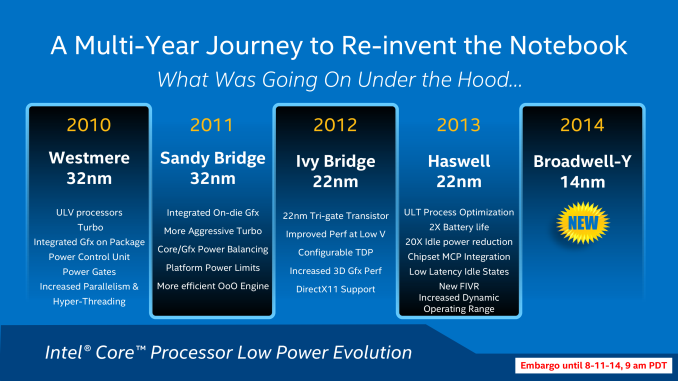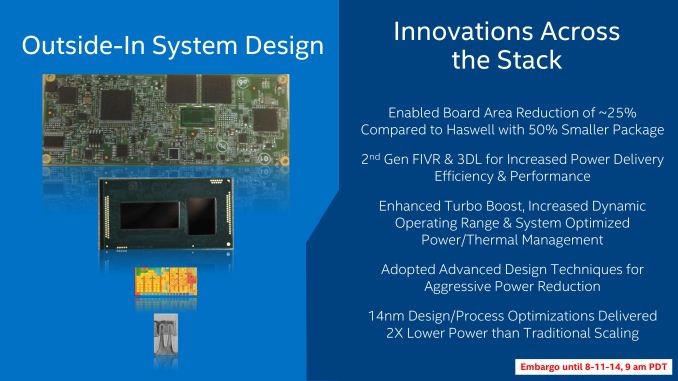Intel Broadwell Architecture Preview: A Glimpse into Core M
by Ryan Smith on August 11, 2014 12:01 PM EST
With Haswell Refresh fully behind us and 2014 now in to its second half, Intel is turning their attention to their next generation of products and processes. Intel’s tick-tock methodology coupled with the long development periods of new products means that the company has several projects in flight at any given time. So while we have seen the name Broadwell on Intel’s roadmaps for some time now, the reality of the situation is that we know relatively little about Intel’s next generation architecture and the 14nm process that it is the launch vehicle for.
Typically we would see Intel unveil the bulk of the technical details of their forthcoming products at their annual Intel Developer Forum, and with the next IDF scheduled for the week of September 9th we’ll see just that. However today Intel will be breaking from their established standards a bit by not waiting until IDF to deliver everything at once. In a presentation coinciding with today’s embargo, dubbed Advancing Moore’s Law in 2014, Intel will be offering a preview of sorts for Broadwell while detailing their 14nm process.
Today’s preview and Intel’s associated presentation are going to be based around the forthcoming Intel Core M microprocessor, using the Broadwell configuration otherwise known at Broadwell-Y. The reason for this is a culmination of several factors, and in all honesty it’s probably driven as much by investor relations as it is consumer/enthusiast relations, as Intel would like to convince consumer and investor alike that they are on the right path to take control of the mobile/tablet market through superior products, superior technology, and superior manufacturing. Hence today’s preview will be focused on the part and the market Intel feels is the most competitive and most at risk for the next cycle: the mobile market that Core M will be competing in.
To that end Intel’s preview is very much a preview; we will see bits and pieces of Broadwell’s CPU architecture, GPU architecture, and packaging, along with information about Intel’s 14nm process. However this isn’t a full architecture preview or a full process breakdown. Both of those will have to wait for Intel’s usual forum of IDF.
Diving into matters then, Core M will be launch vehicle for Broadwell and will be released for the holiday period this year. In fact Intel is already in volume production of the Broadwell-Y CPU and production units are shipping to Intel’s customers (the OEMs) to begin production and stockpiling of finished devices for the holiday launch.
Intel’s decision to initially focus Broadwell on the mobile market comes as the company takes the next step in their plan to extend into the Core processor series into these devices. Arguably, Intel has been slow to response to the rise of ARM devices, whose rapid rise has undercut traditional PC sales and quickly become the biggest threat to Intel’s processor dominance in some number of years. Intel is far from doomed right now, but even they see the potential farther down the line if they do not act.
Intel for their part has responded, but it has taken a step-by-step (multi-year) process that has seen the company progressively build smaller and less power hungry CPUs in order to fit the needs of the mobile market. Since Intel integrated their graphics on-die with Sandy Bridge in 2011, the company has continued to tweak the designs of their products, with Ivy Bridge and Haswell generation products introducing further optimizations and new manufacturing processes. Now on their latest iteration with Broadwell, the company believes they’re turning a corner and have the technology they need to be a leader in the high performance mobile market. It's important to note that despite Intel's best intentions here, Broadwell and Core M remain targeted at premium devices. You won't see these parts in cheap tablets. The duty of doing battle with ARM remains Atom's alone.
Many of these changes ultimately amount to boosting performance and reducing power consumption to a point where power and heat are where they need to be for mobile form factors, either through process efficiency improvements or through better power management and wider dynamic ranges – boosting where it matters and doing a better job of idling between tasks. However as Intel has discovered they not only need to be able to meet the TDP requirements of a tablet but they need to be able to meet the size requirements too. A particularly daunting task when the entire thickness of a device needs to be under 10mm, and the CPU thinner yet.
As a result, coupled with Core M’s performance improvements and power reductions is a strong emphasis on the size of the processor package itself and what Intel could do to reduce it. Intel calls this an outside-in system design, with various parts of Intel focusing on everything from the size of the logic board needed to hold the processor to the thickness of the processor die itself. In the following pages we’ll take a look at Intel’s efforts to get slim, but to kick things off we have a picture of Broadwell-Y from Computex 2014.

From left to right: Broadwell-Y (Core M), Broadwell ULT/ULX and Haswell ULT/ULX
Intel wants a greater foothold in the mobile market and they want it badly. And with Broadwell-Y they believe they finally have what they need to accomplish that goal.














158 Comments
View All Comments
Yesumanu - Monday, August 11, 2014 - link
Not true, assuming Intel will integrate Iris Pro into its mobile CPUs. With HD5200 (iGPU) you can run just about any game on 768p with at least medium settings. Here are some benchmarks for that iGPU: http://www.anandtech.com/show/6993/intel-iris-pro-... I know that TDP there 47W but it includes quad core i7 clocked at 3,6GHz wnich itself draws some power. Intel could improve on that design, put it into its newest CPUs and if they do, they sure will brag about it.Yesumanu - Monday, August 11, 2014 - link
Sorry, I messed up the link. You can erase the dot at the end or use this: http://www.anandtech.com/show/6993/intel-iris-pro-...winterspan - Monday, August 11, 2014 - link
Core M is NOT going to have IRIS ProStevoLincolnite - Monday, August 11, 2014 - link
Half the problem with Intel Decelerators is with the graphics drivers, AMD and nVidia's drivers are gold plated in comparison, sure they are better these days than they used to be, but still hardly ideal.RyuDeshi - Monday, August 11, 2014 - link
In a tablet form factor you are going to encounter severe thermal throttling while gaming, the Anandtech article you linked doesn't have those cooling restraints. Just look at Anantech's article on the Surface Pro 3's thermal throttling. Despite having a slightly better i5, it does worse in most heavy use scenarios.RyuDeshi - Monday, August 11, 2014 - link
Better i5 than the surface pro 2's version I meant to say.mb5625083591 - Monday, August 11, 2014 - link
I think this discussion is completely irrelevant. Very few are going for a graphical gaming tablet (unless it's poker or fruit slices, etc.). That field is dominated by Playstation or XBox on an HDTV.Tablets and convertibles are for Internet Surfing or business documents, the low end for Internet surfing only.
mkozakewich - Thursday, August 14, 2014 - link
No, we use them for gaming, too. If you get a high-end convertible tablet, it's because a regular tablet doesn't do it and you don't need a similarly-sized laptop. This means that you'll either have a proper big gaming rig or you'll be relying on your convertible to game. I'm doing all my gaming on my Surface Pro 1, and I can play most games with my CPU at 700 MHz. (I mean, there are orders of magnitudes of game needs. I'll sometimes switch it to full-throttle when playing a game, when it needs more power.)mb5625083591 - Monday, August 11, 2014 - link
P.S. For the price of an I7 tablet you can buy BOTH an XBox and Playstation, and maybe HDTV also, and play excellent graphical games.kyuu - Tuesday, August 12, 2014 - link
Sure, but there's an obvious difference between gaming on a mobile device and sitting down in front of a TV. So talking about Xboxes and PlayStations is missing the point by a pretty large margin.